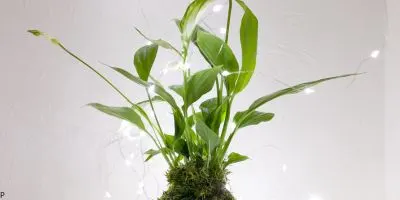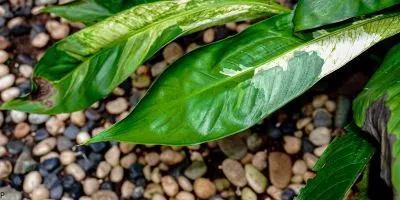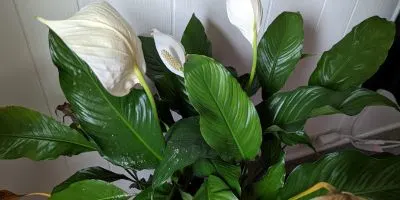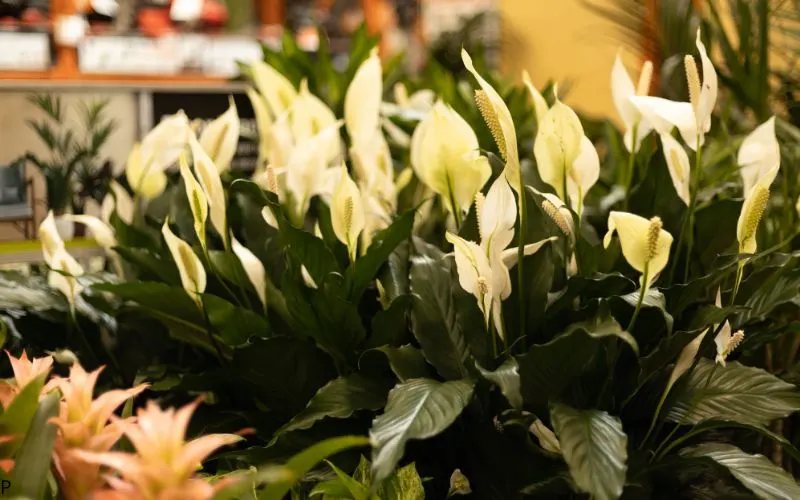- Ever wondered why peace lilies make every home look calmer?
- They bring lush green foliage with elegant white blooms—no fuss, big impact.
- But to keep them happy, the right peace lily care matters. These plants even signal thirst by drooping dramatically—then bounce back after a good drink.
Botanical Overview & Types of Peace Lilies
- Genus: Spathiphyllum (Araceae family), tropical evergreen native to Central and South America
- Grows from creeping stems, with glossy lance-shaped leaves and white/cream “spathe” flowers above the foliage
Popular varieties of Peace Lillies:
1. Spathiphyllum wallisii (“Classic”) – Compact, Reliable (~12 in)

- This is the standard peace lily—dark glossy leaves and pure white blooms.
- Grows up to about 12 in tall, making it perfect for shelves or desks.
- Tolerates low light well and blooms often.
2. “Petite” – Tiny & Cute (~8–10 in)

- Even smaller than wallisii.
- Hits only 8–10 in tall, ideal for small spaces like bathroom counters or apartment nooks.
3. “Domino” – Eye-Catching Variegation (Medium Size)

- Same general size as medium peace lilies (2–3 ft), but with speckled or marbled green-and-white leaves.
- Needs brighter indirect light to keep its variegation crisp.
4. “Mojo Lime” – Chartreuse Charm (Medium Size)

- Features bright, lime-green foliage that stands out in any plant collection.
- Reaches medium size (~2–3 ft) and prefers moderate light to maintain its vivid color.
5. “Sensation” – Lush Giant (Biggest, 4–6 ft)

- The largest peace lily out there—can reach 4–6 ft tall and wide.
- Shows huge, deeply ribbed leaves and impressive blooms.
- Needs ample space and a sturdy pot; still handles lower light fine.
Common Diseases & Solutions
- Leaf tip browning: from low humidity, hard water, or inconsistent watering.
- Fix: Use filtered water, keep soil slightly moist, increase humidity (mist or pebble tray)
- Yellow leaves: from overwatering or poor drainage; also from underwatering or nutrient lack.
- Fix: Let topsoil dry between watering; trim rotting roots; improve drainage .
- Black leaf tips or fungal spots: caused by excess moisture or cold air.
- Fix: Remove affected leaves, apply fungicide, improve airflow, keep temperatures ~19–26 °C (65–80 °F)
- Pests: mealybugs, spider mites, fungus gnats.
- Fix: Blast leaves with water, use insecticidal soap or horticultural oil if needed.
- Root rot: overwatering and lack of drainage.
- Fix: Let soil dry a bit; repot and trim rotten roots
Light, Water, Soil & Temperature for Peace Lily Care
Light Requirements
- Best in bright, indirect light near east or north windows.
- Avoid direct midday sun—can scorch leaves or bleach them.
- In low light, leaves stay green but flowering may drop.
Watering Guide
- Water when the top 1″ of soil is dry.
- Leaves droop when thirsty; perk back soon after watering.
- Avoid standing water and use pots with drainage.
- Use room-temp, filtered/rain water to avoid fluoride and chlorine toxicity.
Soil Mix
- Use loamy, well‑draining potting mix—peat, bark, perlite blend.
- Peace lilies like to be slightly root-bound. Repot every 6 months.
- Ideal pot size: just 2–3″ wider than root ball.
Temperature & Humidity Tips
- Keep between 65–80 °F (18–27 °C); don’t let temps dip below ~55 °F.
- Aim for humidity > 50%, ideally 60–80%. Mist regularly or use pebble trays.
- Avoid cold drafts and hot vents; leaf tips brown quickly in dry air.
Fertilizer & Sprays
- Peace lilies are light feeders.
- Use balanced houseplant fertilizer (20-20-20) at half strength every 6–8 weeks in spring–summer.
- Skip feeding in fall and winter.
- Flush soil every few months to clear salt buildup.
- For fungal issues, use a mild fungicide spray; for pests, apply insecticidal soap.
- For more details checkout this video.
Scientific Benefits
- Removes indoor toxins like formaldehyde, benzene, trichloroethylene.
- Boosts humidity via transpiration, which can ease dry skin and respiratory issues.
- Studies link indoor plants to reduced stress and improved indoor well‑being .
FAQs – Peace Lily Care
How often should I water peace lilies?
Water when the top 1″ of soil is dry—usually every 2-3 days. Soil moisture matters more than schedule.
Why won’t my peace lily bloom?
Check if it has bright, indirect light and occasional feeding. Blooming tends to occur in spring and late summer.
Why do leaf tips turn brown or yellow?
Brown tips = low humidity or water quality. Yellow leaves = too much water, not enough light, or old age.
Can peace lilies survive in low light?
Yes, but blooms may drop. Move to brighter indirect light to encourage flowers.
Is this plant toxic to pets?
Yes. Calcium oxalate crystals can cause mild stomach or mouth irritation in pets and people.
How do I propagate it?
Divide at repotting. Each section needs a few leaves and roots. Plant separately in fresh mix.
Wrap-Up
- Peace lilies bring beauty, calm, and wellness with low effort.
- Key is follow simple care: bright, indirect light; water smartly; good soil; feed lightly; and watch for stress signs.
- Fix most issues by tweaking water, light, humidity, or feeding.
- Enjoy the fresh air and zen vibes from these classic green companions.

